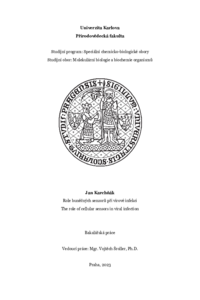Role buněčných sensorů při virové infekci
The role of cellular sensors in viral infection
bachelor thesis (NOT DEFENDED)

View/
Permanent link
http://hdl.handle.net/20.500.11956/179224Identifiers
Study Information System: 242872
Collections
- Kvalifikační práce [21475]
Author
Advisor
Referee
Poláková, Ingrid
Faculty / Institute
Faculty of Science
Discipline
Molecular Biology and Biochemistry of Organisms
Department
Department of Genetics and Microbiology
Date of defense
26. 1. 2023
Publisher
Univerzita Karlova, Přírodovědecká fakultaLanguage
Czech
Grade
Fail
Viry jsou obligátními vnitrobuněčnými parazity způsobujícími širokou škálu onemocnění. Během evoluce se u všech organismů, včetně lidí, vyvinuly mnohé mechanismy, jak se s virovou infekcí vypořádat. První linie kontaktu s virovou infekcí je tvořena mimo jiné receptory přirozené imunity. To jsou zárodečně kódované proteiny zajištující detekci s patogeny asociovaných molekulárních struktur (PAMPs) a molekulárních vzorů asociovaných s vlastním poškozením (DAMPs). Jedním z těchto receptorů je γ interferonem indukovaný protein 16 (IFI16), který je zodpovědný za detekci cizorodé a vlastní poškozené DNA v jádře i v cytoplazmě. Ve své struktuře obsahuje dvě DNA vazebné domény HIN, které slouží k jeho na sekvenci nezávislé vazbě na DNA a jednu PYD doménu zprostředkovávající proteinové interakce. V buňce se podílí na regulaci buněčného cyklu, reguluje diferenciaci, má telomerázovou aktivitu a reguluje buněčné stárnutí. Dále spouští nástup nespecifické imunitní odpovědi a svou aktivitou přímo působí jako restrikční faktor mnoha virů. V reakci na to se u virů vyvinuly mechanismy, jakými se jeho aktivitě vyhýbají, a dokonce ho využívají ve svůj prospěch. Klíčová slova: IFI16, STING, DNA detekce, interferony, restrikční faktor, receptory přirozené imunity
Viruses are obligate intracellular parasites causing a large variety of diseases. Most of their hosts, including humans, have developed particular mechanisms, which are meant to tackle such diseases. First line of defense against viruses are germline encoded Pattern recognition receptors. These receptors are responsible for detection of pathogen associated molecular patterns (PAMPs) and of damage associated molecular patterns (DAMPs). Inteferon γ inducible protein 16 (IFI16) is one of these receptors and is responsible for detecting alien and damaged DNA both in the nucleus and cytoplasm. Its structure contains two sequence independent DNA binding HIN domains and one PYD domain, which mediates its protein-protein interactions. In the cell it functions as a regulator of cell cycle and differentiation. It also has telomerase activity and regulates cell senescence. IFI16 also triggers activation of non-specific immune response and it directly acts as a restrictive factor for many viruses. During evolution these viruses have evolved mechanism which they us to evade its imunne activity or even use it to their advantage. Keywords: IFI16, STING, DNA sensing, interferons, restriction factor, pattern recogniton receptors
